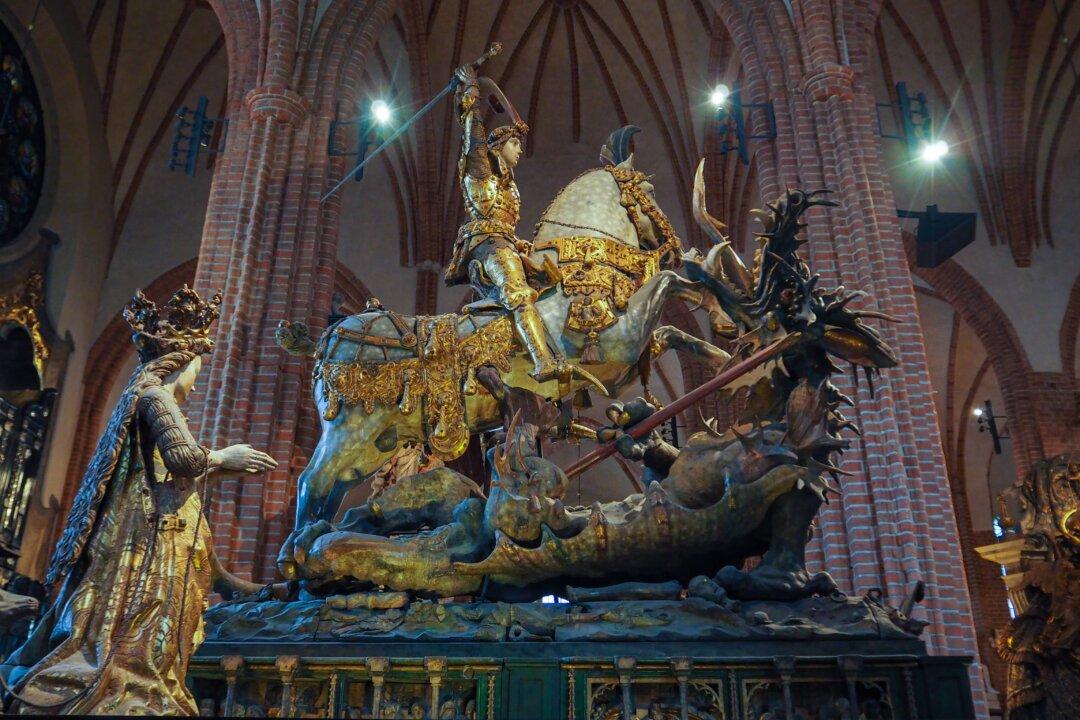In the 1890s, Japanese artist Taki Katei (1830–1901) was at the height of his career, honored with professional accolades and inundated with commissions. In 1893, he was honored as “Imperial Household Artist,” an accolade awarded for his work for Japan’s imperial court.
Despite Taki’s fame, you’ve probably never heard of him.
The reason Taki is “not famous now, even in Japan,” is because in the early 20th century, Taki’s style of painting was seen as out-of-date, wrote curator Rosina Buckland in an email. Buckland, who authored “Painting Nature for the Nation: Taki Katei and the Challenges to Sinophile Culture in Meiji Japan” in 2012, said that artists associated with the government-sponsored Tokyo School of Fine Arts “were regarded as innovative and more worthy of attention.”
Buckland also acted as a guest curator, alongside curator Alex Blakeborough, for the exhibition “Drawing on Nature: Taki Katei’s Japan” at the World Museum in Liverpool, England. Blakeborough is the World Museum’s assistant curator of ethnology.

A total of 82 drawings, consisting of preparatory works for commissions, studies of paintings, and teaching aids for Taki’s students, are on show from the collection of the National Museums Liverpool, a group of museums and galleries that includes the World Museum. The exhibits include works by Taki and his student Ishibashi Kazunori.
The works are in the museum’s permanent collection due to one of Taki’s students, Ishibashi (1876–1928), who studied at the Royal Academy of Arts in London.

Taki Katei Championed Tradition
Born in 1830, Taki grew up in a time when Japan’s art was rich with traditions. Artists borrowed particularly from the traditions of classical Chinese painting, but also followed the tradition of studying from life (people and animals) and botany. Artists started teaching Taki these traditions when he was just 6 years old. At 20 years old, he traveled to Nagasaki to be closer to Chinese culture. At that time, Nagasaki was the only port open in Japan and trade was restricted to the Netherlands, Korea, and China. Here, Taki could mix with Chinese artists and literati who taught him about their culture firsthand.
Over the next 15 or 16 years, Taki traveled around Japan, learning from teachers and by imitating great works; he worked on commissions as he went. In this way, he built up his reputation as well as an archive of works. These enabled him to open an art school in his home when he returned to Tokyo in 1866, Blakeborough said in a phone interview.
By 1868 Japan was in turmoil. The Tokugawa shogun “great general” of the Edo period (1603–1867) was overthrown, ending Japan’s feudal system. Japan’s emperor replaced the shogun, becoming Japan’s supreme ruler, and reigned as the Meiji emperor of “enlightened rule.” Thus began a time of immense transition for Japan, when tradition largely came second to Westernization. Japan welcomed steam locomotives and Western styles of architecture and dress, for example.
The government formed an art school and museum and ran regular public exhibitions. Artists were encouraged to integrate Western styles into their art and adapt works for exhibition halls, glazing and framing paintings rather than creating the traditional silk hanging scrolls.

“Taki did not integrate any stylistic elements from Western painting into his work,” Buckland said. He belonged to the Japan Art Association, a group of artists who “sought to re-energize the established form of Japanese painting,” she said.
The association promoted Japanese traditional art overseas and submitted art at international expositions in Chicago in 1893, and Paris in 1900. They held two annual exhibitions in Tokyo and submitted work to government-sponsored exhibitions.
The group exhibited art that specifically showcased powerful and eye-catching motifs or themes that represented Japanese culture, Buckland explained.
![<span data-sheets-value="{"1":2,"2":"A finished work: \"Prosperity and Fragrance\" by Taki Katei. Paper, pigment, and ink; 15 1/2 inches by 44 1/4 inches. (Keith Sweeney/National Museu"}" data-sheets-userformat="{"2":771,"3":{"1":0},"4":[null,2,14275305],"11":3,"12":0}">A finished work: "Prosperity and Fragrance" by Taki Katei. Paper, pigment, and ink; 15 1/2 inches by 44 1/4 inches. (Keith Sweeney/National Museu</span>m)](/_next/image?url=https%3A%2F%2Fimg.theepochtimes.com%2Fassets%2Fuploads%2F2019%2F11%2F29%2FProsperity-Fragrance-by-Taki-Katei_Keith-Sweeney-600x217.jpg&w=1200&q=75)
‘Drawing on Nature: Taki Katei’s Japan’
Taki’s drawings in the exhibition show just how artists studying with Taki would’ve been taught these traditional art practices. The drawings could be for folding screens, sliding doors, fans, albums, handscrolls, and of course, hanging scrolls, according to the exhibition audio guide.They were “functional pieces used in teaching his students how to paint certain motifs, instructing them in the subject matter of traditional East Asian painting (most of this derived from China) and the whole language of set themes for paintings, some dating back almost a thousand years in China,” Buckland said. These painting themes were detailed in an 1886 book for apprentice artists that Taki contributed to.
In the exhibition, the drawings are pinned rather than hung in the gallery, allowing visitors a glimpse into how Taki’s students learned from him. “His works would have been pinned around his studio for his students to copy, so that’s really what [we’re] doing; we’re continuing his tradition of teaching,” Blakeborough explained.
The amount of detail in many of the drawings is incredible. “I can still remember the first time that I saw these works and being astounded that they were not actually finished pieces,” Blakeborough said.
Most of the work consists of preparatory drawings. For Taki, “to be able to repeat that detail and skill [for the final piece] is astonishing in itself,” Blakeborough said.

Taki had to render the drawings to such an extent if the painting was done on silk, because the tiniest errors are impossible to erase. To perfect silk painting takes incredible patience, skill, and endless practice.
Those principles come through Taki’s drawings in the exhibition. Gridlines appear on some drawings so that the picture could be enlarged when copied. Some of the drawings are annotated with corrections, as in a delightful drawing of a pair of cranes by Ishibashi Kazunori. The birds’ heads have been gently adjusted in red ink by either Taki or Ishibashi.


In “Bush Peonies,” Taki’s delicate pink peony petals hint at a velvet texture and perhaps even a whiff of fine fragrance. And in another, simply called “Deer,” the animal’s fur is so finely rendered that you can sense it’s soft to the touch.

These subjects were not just flights of fancy that Taki wanted to paint. Japanese paintings, just as in Chinese classical art, used nature to portray meaning. The peony brimming with its multiple layers of dense petals represents wealth and prosperity, and a deer represents longevity.
Taki and his students would’ve had to learn this language of East Asian art—a language conveyed not by the written or spoken word, but by the language of symbolism.

Many of these drawings and hanging scrolls are full of meaning. Often, households have 1,000 years’ worth of tradition stored away in their hanging scrolls only to be unrolled on certain occasions. The peony, if in bloom, would be stored until summertime and then hung. A painting such as “Waves of the First Rank,” featuring majestic cranes in undulating waves, could be hung to herald the New Year. The red-crested crane was a symbol of longevity and purity.
To have Taki’s works hung in one exhibition at the same time is fortuitous indeed—for Japanese traditional culture and for art itself. May this be the first of many Taki Katei exhibitions outside of Japan.






